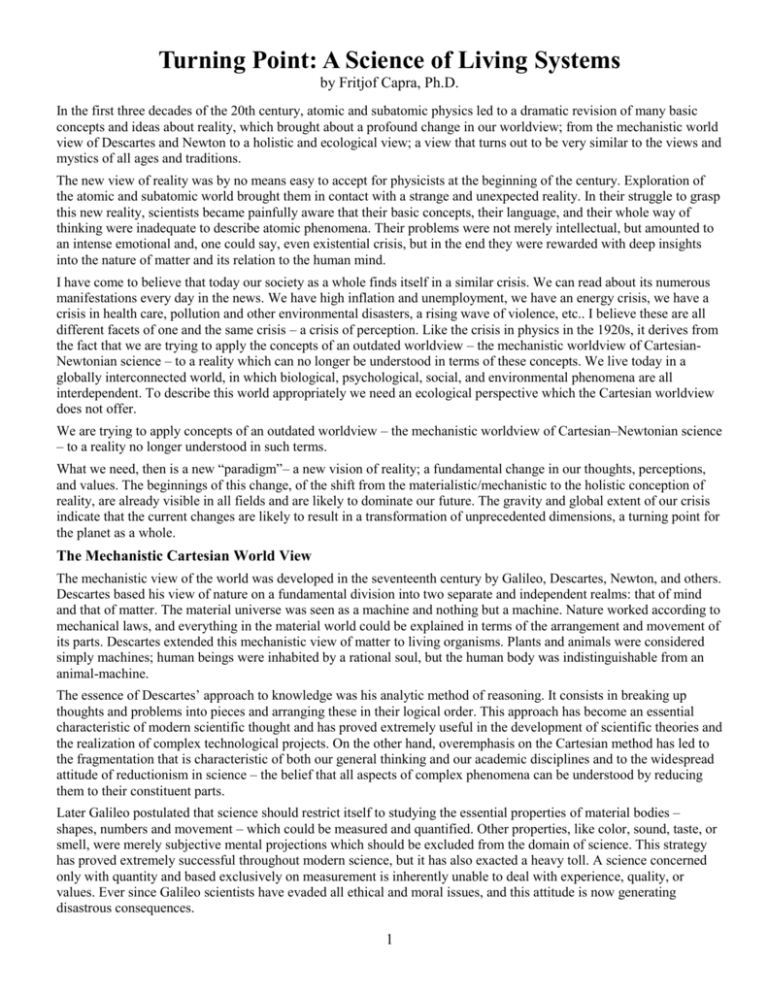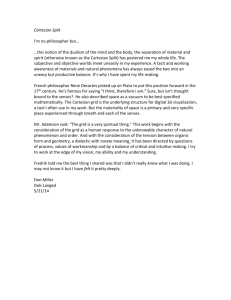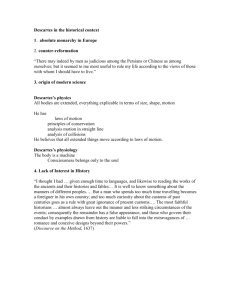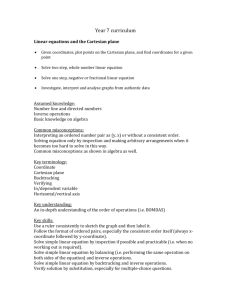Turning Point: A Science of Living Systems
advertisement

Turning Point: A Science of Living Systems by Fritjof Capra, Ph.D. In the first three decades of the 20th century, atomic and subatomic physics led to a dramatic revision of many basic concepts and ideas about reality, which brought about a profound change in our worldview; from the mechanistic world view of Descartes and Newton to a holistic and ecological view; a view that turns out to be very similar to the views and mystics of all ages and traditions. The new view of reality was by no means easy to accept for physicists at the beginning of the century. Exploration of the atomic and subatomic world brought them in contact with a strange and unexpected reality. In their struggle to grasp this new reality, scientists became painfully aware that their basic concepts, their language, and their whole way of thinking were inadequate to describe atomic phenomena. Their problems were not merely intellectual, but amounted to an intense emotional and, one could say, even existential crisis, but in the end they were rewarded with deep insights into the nature of matter and its relation to the human mind. I have come to believe that today our society as a whole finds itself in a similar crisis. We can read about its numerous manifestations every day in the news. We have high inflation and unemployment, we have an energy crisis, we have a crisis in health care, pollution and other environmental disasters, a rising wave of violence, etc.. I believe these are all different facets of one and the same crisis – a crisis of perception. Like the crisis in physics in the 1920s, it derives from the fact that we are trying to apply the concepts of an outdated worldview – the mechanistic worldview of CartesianNewtonian science – to a reality which can no longer be understood in terms of these concepts. We live today in a globally interconnected world, in which biological, psychological, social, and environmental phenomena are all interdependent. To describe this world appropriately we need an ecological perspective which the Cartesian worldview does not offer. We are trying to apply concepts of an outdated worldview – the mechanistic worldview of Cartesian–Newtonian science – to a reality no longer understood in such terms. What we need, then is a new “paradigm”– a new vision of reality; a fundamental change in our thoughts, perceptions, and values. The beginnings of this change, of the shift from the materialistic/mechanistic to the holistic conception of reality, are already visible in all fields and are likely to dominate our future. The gravity and global extent of our crisis indicate that the current changes are likely to result in a transformation of unprecedented dimensions, a turning point for the planet as a whole. The Mechanistic Cartesian World View The mechanistic view of the world was developed in the seventeenth century by Galileo, Descartes, Newton, and others. Descartes based his view of nature on a fundamental division into two separate and independent realms: that of mind and that of matter. The material universe was seen as a machine and nothing but a machine. Nature worked according to mechanical laws, and everything in the material world could be explained in terms of the arrangement and movement of its parts. Descartes extended this mechanistic view of matter to living organisms. Plants and animals were considered simply machines; human beings were inhabited by a rational soul, but the human body was indistinguishable from an animal-machine. The essence of Descartes’ approach to knowledge was his analytic method of reasoning. It consists in breaking up thoughts and problems into pieces and arranging these in their logical order. This approach has become an essential characteristic of modern scientific thought and has proved extremely useful in the development of scientific theories and the realization of complex technological projects. On the other hand, overemphasis on the Cartesian method has led to the fragmentation that is characteristic of both our general thinking and our academic disciplines and to the widespread attitude of reductionism in science – the belief that all aspects of complex phenomena can be understood by reducing them to their constituent parts. Later Galileo postulated that science should restrict itself to studying the essential properties of material bodies – shapes, numbers and movement – which could be measured and quantified. Other properties, like color, sound, taste, or smell, were merely subjective mental projections which should be excluded from the domain of science. This strategy has proved extremely successful throughout modern science, but it has also exacted a heavy toll. A science concerned only with quantity and based exclusively on measurement is inherently unable to deal with experience, quality, or values. Ever since Galileo scientists have evaded all ethical and moral issues, and this attitude is now generating disastrous consequences. 1 The conceptual framework created by Galileo and Descartes was completed triumphantly by Newton, who developed a consistent mathematical formulation of the mechanistic view of nature. From the second half of the seventeen century to the end of the nineteenth, the Newtonian model of the universe dominated all scientific thought. The natural sciences, as well as the humanities and social sciences, all accepted the mechanistic view of classical physics as the correct description of reality and modeled their own theories accordingly. When psychologists, sociologists, or economists wanted to be scientific, they turned toward the basic concepts of Newtonian physics, and even now they hold on to these concepts when physicists have gone far beyond them. Influence of Cartesian– Newtonian Thought In biology the Cartesian view of living organisms as machines, constructed from separate parts, still provides the dominant conceptual framework. The influence of the reductionist biology on medical thought resulted in the so-called biomedical model, which constitutes the conceptual foundation of modern scientific medicine. The human body is regarded as a machine that can be analyzed in terms of its parts; disease is seen as the malfunctioning of biological mechanisms which are studied from the point of view of cellular and molecular biology; the doctor’s role is to intervene, either physically or chemically, to correct the malfunctioning of a specific mechanism, different parts of the body being treated by different specialists. To associate a particular illness with a definite part of the body is, of course, very useful in many cases. But modern scientific medicine has overemphasized this reductionist approach and has developed its specialized disciplines to a point where doctors are often no longer able to view illness as a disturbance of the whole organism, nor to treat it as such. What they tend to do is to treat a particular organ or tissue, and this is generally done without taking the rest of the body into account, let alone considering the psychological and social aspects of the patients illness. Doctors are often no longer able to view illness as a disturbance of the whole organism, nor to treat it as such. Like biology and medicine, the science of psychology has been shaped by the Cartesian paradigm. Psychologists, following Descartes, adopted a strict division between mind and matter. Based on this division, three approaches were developed for the study of the human psyche, thus creating three major currents of psychological thinking that have dominated psychology for most of the twentieth century. The structuralists studied the mind through introspection and tried to analyze consciousness into its basic elements, while behaviorists concentrated exclusively on the study of behavior and so were led to ignore or deny the existence of mind altogether. Freud developed a new, revolutionary theory of the human mind and psychoanalysis – yet again his concepts were Newtonian in nature. They all modeled themselves after classical physics, incorporating concepts of Newtonian mechanics into their theoretical frameworks. Present-day economics, like most social sciences, is also fragmentary and reductionist. It fails to recognize that the economy is merely one aspect of a whole ecological and social fabric. Economists tend to dissociate the economy from this fabric, in which it is embedded, and to describe it in terms of simplistic and highly unrealistic theoretical models. Most of their basic concepts – efficiency, productivity, GNP, etc. – have been narrowly defined and are used without their wider social and ecological context. Because of its narrow, reductionist framework, conventional economics is inherently anti-ecological. In particular, the social and environmental costs generated by economic activities are neglected. Consequently, the current economic concepts and models are no longer adequate to map economic phenomena in a fundamentally interdependent world, and hence economists have been unable to understand major economic problems of our time. Undifferentiated growth– economic, technological and institutional growth – is still regarded by most economists as the sign of a “healthy” economy, although it is now causing ecological disaster, widespread corporate crime, social disintegration, and ever increasing likelihood of wars. The situation is further aggravated by the fact that most economists, in a misguided striving for scientific rigor, neglect to acknowledge explicitly the value system on which their models are based. In doing so, they tacitly accept the highly imbalanced set of values which dominates our culture and is embodied in our social institutions. The new paradigm is being formulated largely outside our academic institutions, which remain too closely tied to the Cartesian framework to appreciate new ideas. I have found the Chinese terminology of yin and yang very useful for describing this cultural imbalance. With the development of the mechanistic worldview, our culture has consistently favored yang values and neglected their yin counterparts. We’ve favored self-assertion over integration, analysis over synthesis, rational knowledge over intuitive wisdom, science over religion, competition over cooperation, expansion over conservation, and so on. 2 From the earliest times of Chinese culture, yin was also associated with the feminine and yang with the masculine, and in our time feminists have repeatedly pointed out that the values and attitudes favored by our society are those of patriarchal cultures. The Cartesian and the yang-oriented value system have thus been supported by patriarchy, but like the Cartesian paradigm, patriarchy is now in its decline, and the feminist perspective will be an essential aspect of the new vision of reality. The New Paradigm The new paradigm emerged in physics at the beginning of the century and is now emerging in various other fields– biology, medicine, psychology, economics, politics, etc. It consists not only of a new value system, and it is reflected in new forms of social organization and new institutions. It is being formulated largely outside our academic institutions, which remain too closely tied to the Cartesian framework to appreciate the new ideas. The material world, according to contemporary physics, is not a mechanical system made of separate objects, but rather appears as a complex web of relationships. Subatomic particles cannot be understood as isolated, separate entities, but have to be seen as interconnections, or correlations, in a network of events. The notion of separate objects is an idealization which is often very useful but has no fundamental validity. All such objects are patterns in an inseparable cosmic process, and these patterns are intrinsically dynamic. Subatomic particles are not made of any material substance. They have a certain mass but this mass is a form of energy. Energy, however, is always associated with processes, with activity; it is a measure of activity. Subatomic particles, then, are bundles of energy, or patterns of activity. The emerging worldview of modern physics is inherently holistic and ecological. The energy patterns of the subatomic world form stable atomic and molecular structures which build up matter and give it its macroscopic solid appearance thus making us believe that it is made up of some material substance. At the everyday, macroscopic level, the notion of a substance is quite useful, but at the atomic level it no longer makes sense. Atoms consist of particles and these particles are not made of any material stuff. When we observe them, we never see any substance; what we observe are dynamic patterns, continually changing into one another – a continuous dance of energy. The Systems View of Life The worldview of modern physics is holistic and ecological. It emphasizes the fundamental interrelatedness and interdependence of all phenomena, and also the intrinsically dynamic nature of physical reality. To extend this view to the description of living organisms we have to go beyond physics, and there is now a framework which seems to be a natural extension of the concepts of modern physics. This framework is commonly known as systems theory, or general systems theory. The term “systems theory” is somewhat misleading, since it is not a well-defined theory, like relativity theory or quantum theory. It is rather a particular approach, a language, a perspective. The systems approach is concerned with the description of systems, which are integrated wholes that derive their essential properties from the interrelations between their parts. The systems approach does not focus on the parts, but rather on the interrelations and interdependencies between the parts. Every living organism is a living system– a single cell, a plant, an animal, or a human being. But living systems need not be individual organisms. There are social systems, such as family or a community, and then there are ecological systems, or ecosystems, in which networks of organisms are interlinked, together with various inanimate components, to form an intricate web of relations involving the exchange of matter and energy in continual cycles. All these are living systems which exhibit similar patterns of organization. An important aspect of living systems is their tendency to form multileveled structures of systems within systems. For example, the human body consists of organs, each organ of tissue, and each tissue of cells. All these are living organisms, or living systems, which consist of smaller parts and, at the same time, act as parts of larger wholes. Living systems, then exhibit a stratified order, and there are interconnections and interdependencies between all system levels, each level interacting and communicating with its total environment. The systems approach is concerned with the description of systems, which are integrated wholes that derive their properties from the interrelations between their parts. Self-Organization What, then are the patterns of organization that are characteristic of life? They include a variety of processes and phenomena which can be seen as different aspects of the same dynamic principle, the principle of self-organization. A 3 living organism is a self-organizing system, which means that its order in structure and function is not imposed by the environment but is established by the system itself. Self-organizing systems exhibit a degree of autonomy; they tend to establish their size according to internal principles of organization, independent of environmental influences. This does not mean living systems are isolated from their environment; on the contrary, they interact with it continually, but this interaction does not determine their organization. A theory of self-organizing systems has been worked out over the last decade in considerable detail by a number of researchers from various disciplines under the leadership of the Belgian Nobel Laureate Ilya Prigogine. One of the most important characteristics of self-organization is the fact that self-organizing systems are “always at work”. They have to maintain a continuous exchange of energy and matter with their environment to stay alive. This exchange involves taking in ordered structures, such as food, breaking them down and using some of the components to maintain or even increase the order of the organism. This process is called metabolism. Another important aspect of the continual activity of living systems is the process of self-renewal. Every living organism continually renews itself; cells breaking down and building up structures, tissues, and organs replacing their cells in continual cycles. In spite of this continual change, the organism maintains its overall structure and appearance. Its components are continually renewed and recycled, but the pattern of organization remains stable. Other aspects of self-organization which are closely related to self-renewal are the phenomena of self-healing, regeneration, and environmental adaptation. A living system can be described as interdependent variables which oscillate between certain limits, so that the system is in a state of continual fluctuation. In all these processes, fluctuations play a very central role. A living system can be described in terms of interdependent variables which oscillate between certain limits, so that the system is in a state of continual fluctuation. Such a state is known as homeostasis. It is a state of dynamic balance which displays great flexibility. When there is some disturbance, the system tends to return to its original fluctuating state by adapting in various ways to the disturbance. Feedback mechanisms come into play which tend to reduce any deviation from the balanced state. The aspects of self-organization described so far can be seen as processes of self-maintenance. What makes the understanding of living systems difficult is the fact that they have not only a tendency to maintain themselves in their dynamic state but, at the same time, also show a tendency to transcend themselves, to reach out creatively beyond their boundaries and limitations to generate new structures and new forms or organization. This principle of selftranscendence manifests itself in the processes of learning, development, and evolution. According to the systems view, the Darwinian theory of evolution represents only on of two complementary views which are both necessary to understand the phenomenon of evolution. The other view sees evolution as an essential manifestation of self-organization which leads over time to an ordered unfolding of complexity. The two complementary tendencies of self-organization: systems – self-maintenance and self-transcendence – are in continual dynamic interplay, and both of them contribute to evolutionary adaptation. A New Concept of Mind Gregory Bateson has proposed to define mind as a systems phenomenon characteristic of living organisms, societies, and ecosystems. In Bateson’s view, mind is a necessary, inevitable consequence of a certain complexity which begins long before organisms develop a brain and a higher nervous system. Bateson’s criteria for mind turn out to be closely related to the characteristics of self-organizing systems. Indeed, mind is an essential property of living systems. As Bateson put it, “Mind is the essence of being alive.” From the systems point of view, life is not substance or force, and mind is not an entity interacting with matter. Both life and mind are manifestations of the same set of systemic properties; a set of processes which represent the dynamics of selforganization. This new concept of mind will be of tremendous value in our attempts to overcome the Cartesian division. Mind and matter no longer appear to belong to two separate categories, but can be seen to represent merely different aspects of the same phenomenon. For example, the relationship between mind and brains, which has confused countless scientists ever since Descartes, becomes now quite clear. Mind is the dynamics of self-organization, and the brain is the biological structure through which this dynamic is carried out. 4 Mind can be defined as the dynamics of self-organization. The fact that the living world is organized in multileveled structures means that there also exist levels of mind. In the human organism, for example, there are various levels of “metabolic” mentation involving cells, tissues, and organs, and there is the neural mentation of the brain which, itself, consists of multiple levels corresponding to different stages of human evolution. The totality of these mentations constitutes what I would call the human mind, or psyche. In the stratified order of nature, individual human minds are embedded in the larger minds of social and ecological systems, and these are integrated into the planetary mental systems, which in turn must participate in some kind of universal or cosmic mind. The conceptual framework of the new systems approach is in no way restricted by associating this cosmic mind with the traditional idea of God. In this view deity is not manifest in any personal form, but represents nothing less than the self-organizing dynamics of the entire cosmos. Science and Spirituality The new vision of reality is an ecological vision which goes far beyond the immediate concerns with environmental protection. It is supported by modern science, and in particular by the new systems approach, but it is rooted in a perception of reality that goes beyond the scientific framework to an intuitive awareness of the oneness of all life, the interdependence of its multiple manifestations, and its cycles of change and transformation. When the concept of the human spirit is understood as the mode of consciousness in which the individual feels connected to the cosmos as a whole, it becomes clear that ecological awareness is truly spiritual. The idea of the individual being linked to the cosmos is expressed in the Latin root of the word religion, religare (“to bind strongly”) or the Sanskrit yoga which means “union”. It is thus not surprising that the new vision of reality is consistent with many ideas in mystical traditions. Two basic themes emerge again and again from the study of living and nonliving matter and are also repeatedly emphasized in the teachings of mystics– the universal interconnectedness and interdependence of all phenomena, and the intrinsically dynamic nature of reality. Although mystical views of consciousness go far beyond the framework of contemporary science, they are by no means inconsistent with the modern systems concepts of mind and matter. The concepts of process, change, and fluctuation, which play such a crucial role in the systems view of living organisms, are emphasized in the Eastern mystical traditions. The idea of fluctuations as the basis of order, which Prigogine introduced into modern science, is the major theme in Taoism. In fact, the interdependence and the nonlinear nature of all reality are emphasized throughout Eastern mysticism. Social Implications The systems view of life has many important consequences not only for science but also for society and everyday living. It will influence our ways of dealing with health and illness, our relation to the natural environment, and will change many of our political structures. All these changes are already taking place. The paradigm shift is not only about the future; it is happening right now. Cultural historians have often pointed out that the evolution of cultures is characterized by a regular pattern of rise, culmination, decline, and disintegration. The decline will occur when a culture has become too rigid – in its technologies, ideas, or social organization – to meet the challenge of changing conditions. This loss of flexibility is accompanied by a general loss of harmony which inevitably leads to the outbreak of social discord and disruption. During this process of decline and disintegration, while the cultural mainstream has become petrified by clinging to fixed ideas and rigid patterns of behavior, creative minorities will appear on the scene and transform some of the old elements into new configurations which become the new rising culture. While transformation is taking place, the declining culture refuses to change, clinging ever more rigidly to its outdated ideas; nor will the dominant social institutions hand over their leading roles to the new cultural forces. But they will inevitably go on to decline while the rising culture will continue to rise, and eventually will assume its leading role. As the turning point approaches, the realization that evolutionary changes of this magnitude cannot be prevented by short-term political activities provides our strongest hope for the future. -----------Fritjof Capra holds a Ph.D. in theoretical physics from the University of Vienna and has held many research and teaching positions in physics and the philosophy of science. He is the author of The Tao of Physics, The Turning Point, Hidden Connections and others. He is also developing ecological literacy programs for public education. To read more about the author and living systems see: www.fritjofcapra.net 5








